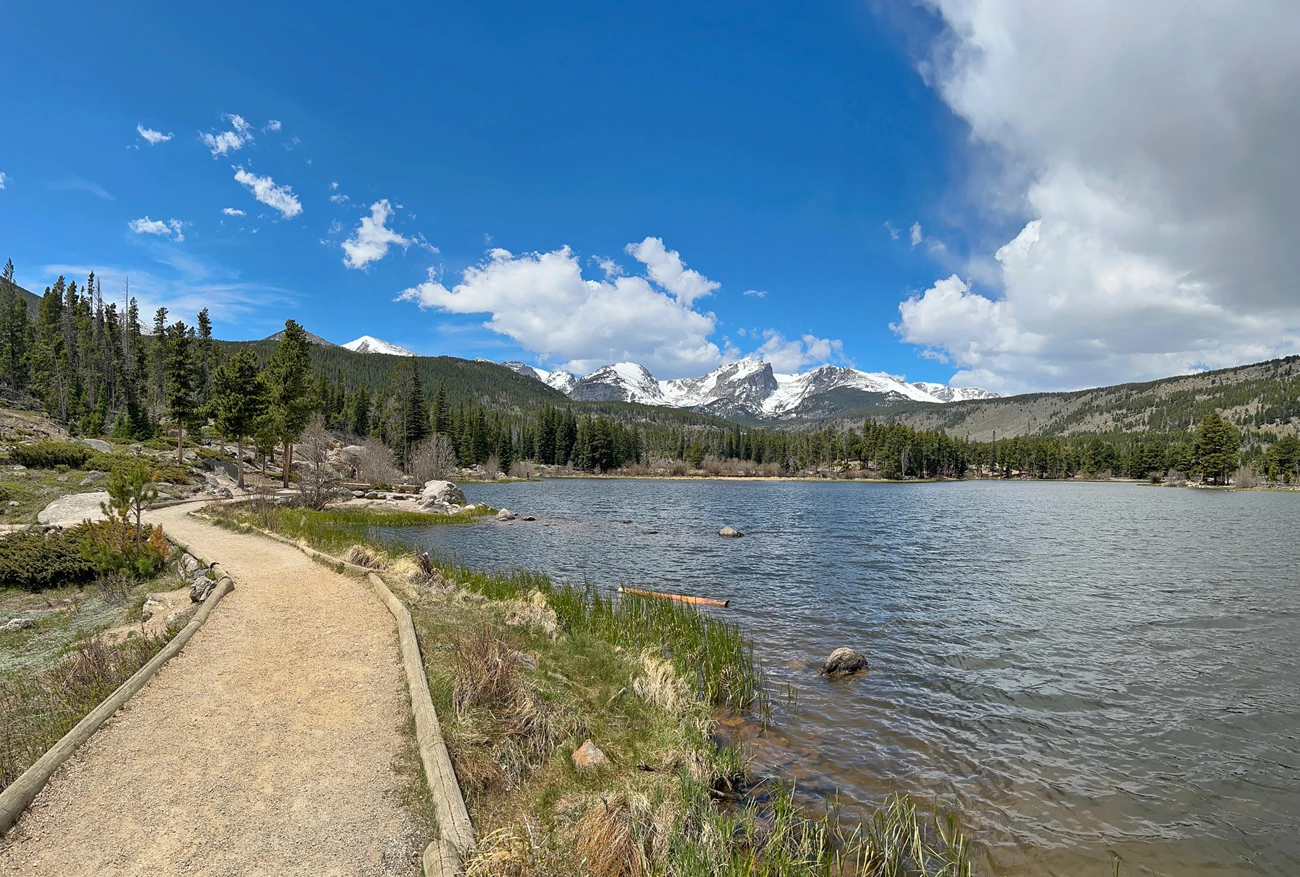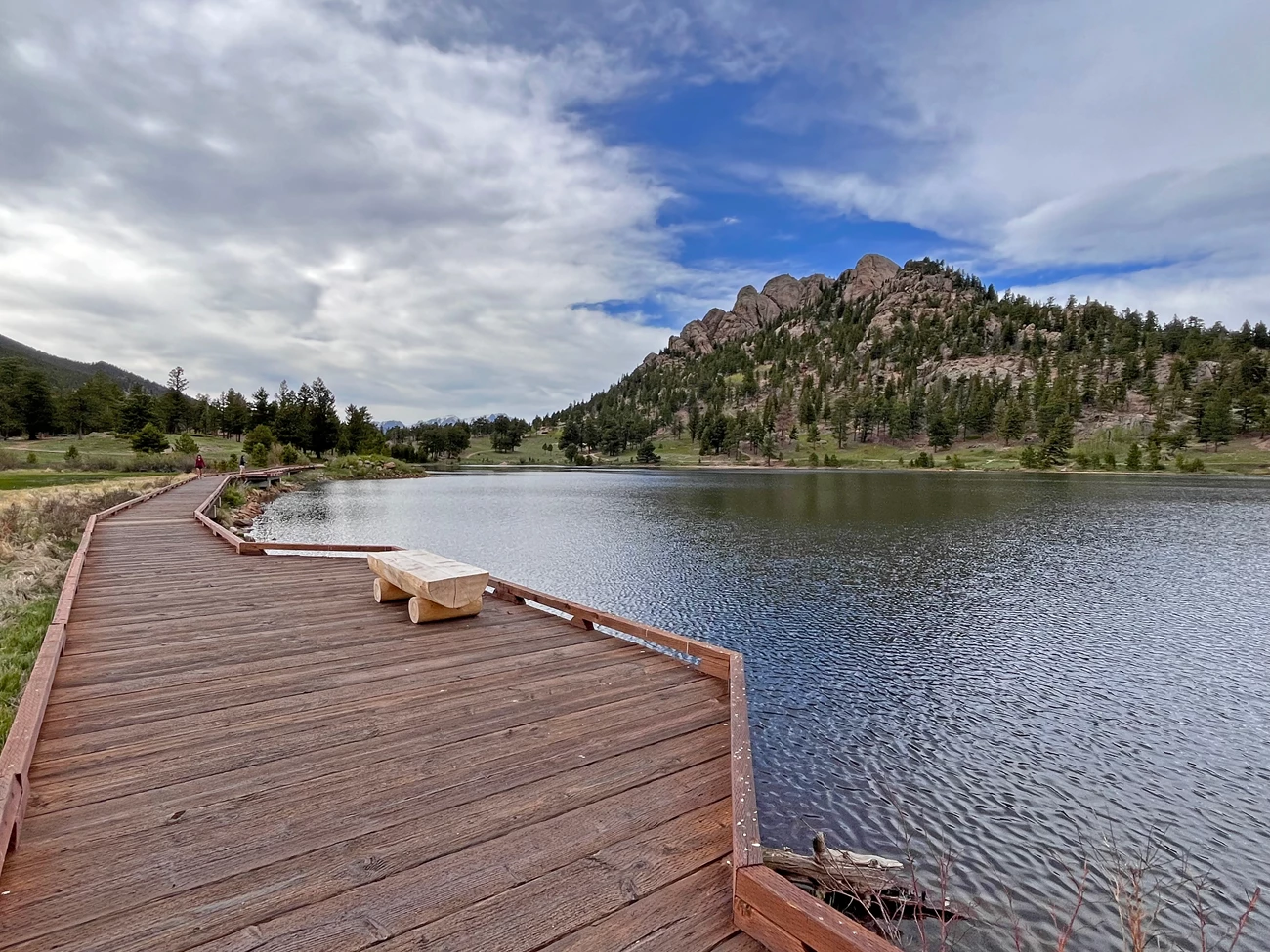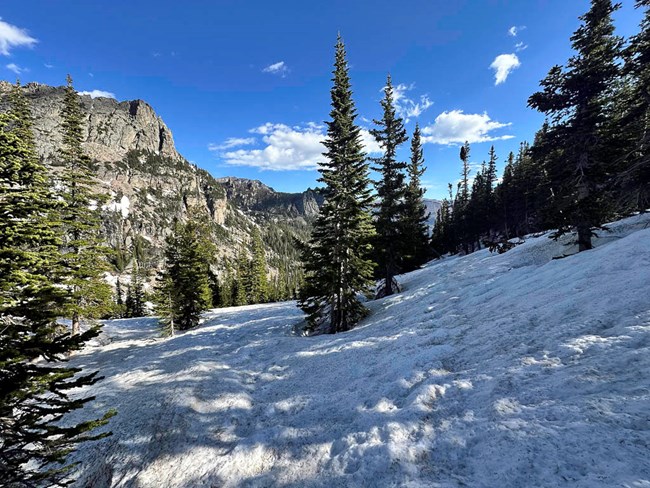
NPS Photo What Are Trails Like in Rocky Mountain National ParkUpdated June 16, 2025Conditions on trails are changing rapidly and frequently (daily & even hourly) as snow continues to melt out. This report is best used as a general guide. By the time you start your hike, conditions on trails in RMNP could be the same, better, or worse than what is described in this report. Remember - Your Safety is Your Responsibility.
|
| Bear Lake (Site #322) elevation 9500’ 0 inches of snow |
Long Draw Reservoir (Site #1123) elevation 9980’ 0 inches snow |
Stillwater Creek (Site #793) elevation 8720’ 0 inch snow |
| Copeland Lake (Site #412) elevation 8600’ 0 inch snow |
Never Summer (Site #1031) elevation 10,280’ 7 inches snow |
Wild Basin (Site #1042) elevation 9560’ 0 inches snow |
| Lake Irene (Site #565) elevation 10,700’ 0 inches snow |
Phantom Valley (Site #688) elevation 9030’ 0 inches snow |
Willow Park (Site #870) elevation 10,700’ 0 inches snow |
Rocky Mountain National Park Trail Conditions Report - Updated June 11, 2025
| Destination | Date | Description of Conditions Found | Reported By |
| Bear Lake Loop Trail | June 13, 2025 | The Bear Lake Loop trail is mostly clear of snow and ice. There is a snowy/icy patch on the southside of the trail, but it is easy to walk around. Several places on the south side of the trail are wet and muddy. Most of the trail is dry. | NPS Volunteer |
| Bear Lake to Nymph Lake | June 13, 2025 | The trail from Bear Lake to Nymph Lake is clear of snow and ice and dry. | NPS Volunteer |
| Nymph Lake to Dream Lake | June 13, 2025 | Most of this trail is now clear of snow. The area just below Nymph Lake Overlook is now completely free of snow and ice. There are wet and muddy sections on the trail. As you get closer to Dream Lake, be prepared for snow 3-4 feet deep on and near the trail. | NPS Volunteer |
| From Dream Lake to Emerald Lake | June 13, 2025 | After crossing the narrow footbridge just below Dream Lake, be prepared for deep snow on the trail. Some sections are still 3-4 feet deep. Other sections have melted out, but are very wet and muddy. Hiking boots with good traction are advised. Hiking poles and traction devices may be helpful on the snow-covered and ice sections. | NPS Volunteer |
| From Dream Lake to Lake Haiyaha | June 13, 2025 | At the Dream Lake and Lake Haiyaha Junction, the trail is covered with snow and ice. Traction devices and hiking poles are advised. After the first 1/4 to 1/2 mile, the trail has melted out and is fairly easy to follow. There are still some sections of trail with very deep snow and a steep drop that makes it impossible to avoid. It is easy to posthole in these sections. GPS navigation can be very helpful to help you follow the correct trail. There are a few sections where it is difficult to see where the trail is. The Haiyaha traverse is now free of snow and fairly dry. There are a few places where the trail to Lake Haiyaha is waterlogged. It can be difficult to rock-hot across and avoid wet feet. One waterlogged section is at the Mills-Loch Junction. | |
| Bear Lake to Lake Helene | June 10, 2025 | The trail is clear of snow and ice to the Bierstadt Lake Junction (about 0.5 miles up the trail). There is still some snow and ice on the trail between Bierstadt Lake Junction and the Flattop Mountain Junction. From the Flattop Mountain Junction to Lake Helene, sections of the trail are still covered with snow. Some sections have melted and are snow free. With the snow, it can still be difficult to navigate correctly. A navigation device like a GPS and a map are strongly advised. Winter navigation skills are needed. The slope is slippery and traction devices and hiking poles are advised. Be Aware - From Lake Helene, the traverse towards Odessa Lake and Fern Lake quickly steepens and becomes very slippery. There is a steep drop into a gully below. This section of trail remains covered with snow and ice. Traveling from Lake Helene to Odessa Lake on this stretch of trail is not advised until the snow melts in likely 2 to 4 more weeks. |
NPS Volunteer |
| Deer Mountain Trail | June 9, 2025 | The Deer Mountain Trail is now clear of snow and ice. | NPS Volunteer |
| Longs Peak Trailhead to Chasm Lake | June 9, 2025 | From Longs Peak Trailhead to Chasm Lake, the trail is mostly snow free except for a significant section near treeline and the Chasm Crossing. Traction devices, hiking poles, and an ice axe are advised if traveling on the Chasm Crossing. For more details, see the park's Longs Peak Conditions Report. | NPS Volunteer |
| Longs Peak Trailhead to Eugenia Mine to Estes Cone | June 9, 2025 | From Longs Peak Trailhead to the Eugenia Mine Trail Junction is clear of snow and ice. Most of the trail is clear of snow and ice all the way to Estes Cone. There is a significant amount of water flowing on the trail near Eugenia Mine. | NPS Volunteer |
| Bear Lake to Nymph Lake | June 8, 2025 | The trail from Bear Lake Trailhead to Nymph Lake is clear of snow and ice. If you continue up the trail past Nymph to Dream Lake, be prepared for snow on the trail. | Park Visitor |
| Fern Lake Trailhead to Fern Lake | June 7, 2025 | From Fern Lake Trailhead to Fern Lake, the trail is clear of snow and ice. There were some wet and muddy sections of the trail. | Park Visitor |
| From Timber Lake Trailhead to Timber Lake | June 4, 2025 | The first three miles of the trail is clear of snow and ice. Snow is on the trail beyond that point. The snow is becoming soft and hikers are postholeing up to their knees. There are downed trees on the trail of varying sizes. | Park Ranger |

NPS
Submit Your Own Trip Report
Have you been hiking recently on any trail inside Rocky Mountain National Park? Would you like to share with others what the trail was like? To submit a trail conditions report:
- 💻 Fill out and submit an RMNP Trail Conditions Report online
- ☎️ Call Rocky Mountain National Park staff at 970-586-1206 and share a report over the phone.
- 🏫 Stop by a Rocky Mountain National Park visitor centers and fill out a report in person.
Recent Photos Showing Trail Conditions in Rocky Mountain National Park

NPS

NPS Photo

NPS Photo/P.Allison

NPS Photo/Allison

NPS/P.Allison
Things to Know Before Your Next Hike:
Plan ahead and be prepared for varying weather and conditions. Remember- Your safety is in your hands! Trails inside Rocky Mountain National Park can experience extreme weather and conditions can change quickly. In RMNP, all four seasons can happen in one day!
Any Time of Year - Be prepared: Choose your hiking destination wisely. Know your personal limits and choose a trail that meets your goals within your limits. Be willing to turn back for any reason. Always tell someone where you are going, where you will be parked, what your intended route is, when you plan to be back home, and then let them know when you return.
Lakes: Always proceed with caution around icy lakes, especially around inlets, outlets, and rocks, where the ice can be thin.
Route-finding is important. RMNP trails are not marked in winter and following other tracks is not advised, as you don’t know where they lead, and wind and new snow obliterate tracks. When trails are covered in snow, signs may not be visible. Carry a map and compass or GPS and know how to use them.
Be Prepared for Conditions with Essentials. It is important to bring and use the right gear, especially suitable gear for the season.Plan that trails can be snowy much of the year. Depending on conditions and elevation, some trails can be icy and snowy September through midsummer.
Important questions to consider - Do you have the right gear and equipment for your hike? Do you know how to use it?
- Traction devices for the bottom of your boots and hiking poles are strongly recommended, as trails may be icy. Or depending on conditions after snowstorms or at higher elevations, the snow may be deep enough that snowshoes are advised. Hiking poles are helpful for stability.
- Food and water are essential no matter how long your hike.
- Wear layers of wicking clothing and pack extra socks.
- Bring waterproof outer layers (rain gear/snow gear/windproof jacket) and extra layers for warmth. During the summer season, be prepared for afternoon rain storms.
- Pack a hat and gloves, sunglasses or goggles, and sunscreen any time of year. Sunlight can damage your eyes and skin, even on cloudy days. Protect your eyes from the sun and blowing snow.
- It is advised to wear closed-toed footwear with a treaded sole when hiking. Slick-soled shoes without good traction, sandals, high-heeled shoes, flip flops, and/or clogs can all lead to cold toes, wet feet, and slips, trips and falls.
Roads can be icy and snowy, especially in shady areas. Be prepared and know how to drive in wintery conditions. If the Colorado Vehicle Traction Law is in place in RMNP, for your safety and the safety of other motorists, all vehicles must have properly rated tires with a minimum of 3/16” tread or an approved traction control device.
Pets: Pets are prohibited on all trails, tundra, and meadows areas in Rocky Mountain National Park. For details, see RMNP's Pets Webpage.

